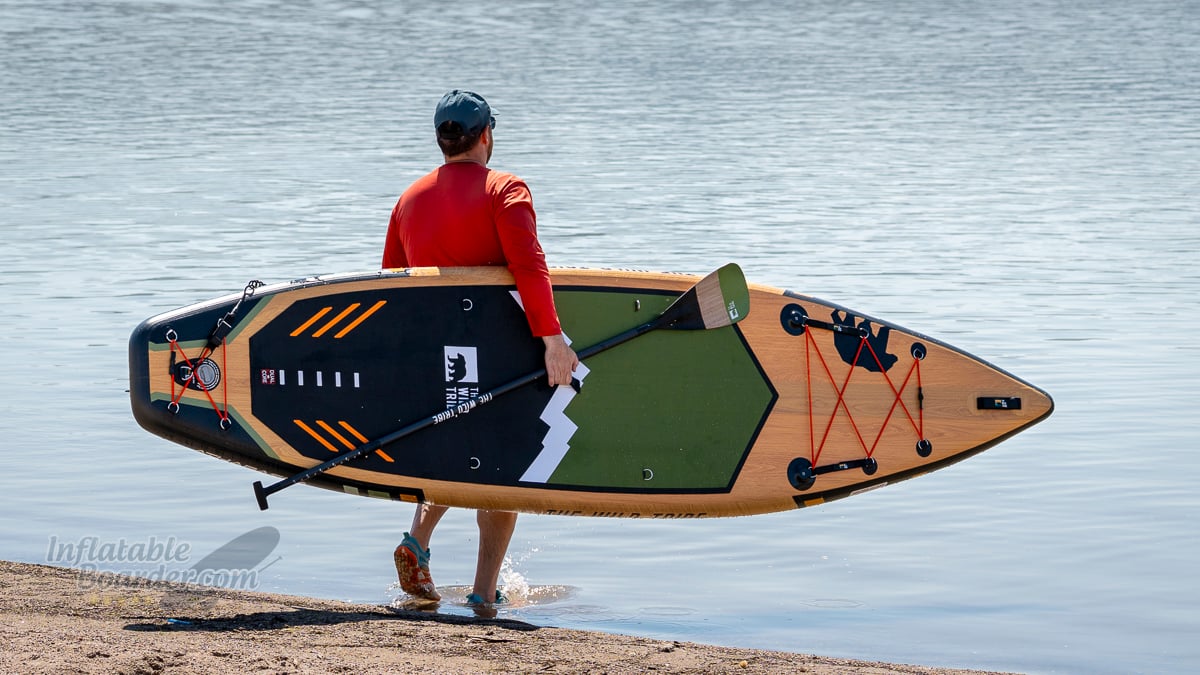
The Wild Tribe Athabasca 11’ is an all-around and touring paddleboard crossover for all skill levels.
The Wild Tribe Athabasca 11’ iSUP Review — Overview
The Wild Tribe Athabasca 11’ joins the SUP world in the ever-growing category of what I like to refer to as performance crossover iSUPs. These paddle boards offer beginner-friendly all-around performance, but are designed to grow with you as your skills progress. Easy to learn on, Easy to advance with, and Easy to see why this is quickly becoming my favorite style of stand-up paddleboard.
Editor’s Note: The Wild Tribe’s board naming conventions can be a little confusing. Rather than giving specific shapes a single model name, the name is attached to the graphic design of the board and modified for the shape. In this review we are examining the Athabasca 11’ – an 11’ x 32” all-around/touring crossover, not the Athabasca S – a 12’6 x 30” touring board. For a review of that shape, see our Wild Tribe Columbia S review (coming soon). In this review we refer to this board as both the Athabasca 11’ or Athabasca.
— The Wild Tribe Athabasca 11’ Ratings and Review Summary —
The Wild Tribe Athabasca 11’
-
Construction & Durability
-
Features and Versatility
-
Stability
-
Speed
-
Maneuverability
-
Tracking
Overall Score
The Wild Tribe Athabasca is a great all-around iSUP with a fun feel on the water.
Pros
- 4.7” thickness provides improved stability and a more connected feel to the water
- Cross-woven drop stitching and fusion PVC keep the board lightweight, but feeling rigid on the water
- Welded seams offer improved durability and longevity, especially in hot climates
- US fin box for the center fin allows for easy replacement and customization
- Clean looks and large feature set that doesn’t crowd the deck
- Carbon fiber/nylon hybrid paddle
- 3 year warranty
Cons
- The rear cargo area is quite small and covers the leash connection point
- Side fin boxes use a propriety fin system
The Wild Tribe Athabasca 11’ iSUP Review — Construction and Durability
The Wild Tribe’s newest boards – the Athabasca and Columbia – use new materials and construction for a lightweight and durable build.

The rail band is heat welded to the main board for improved durability.
A big update for this year’s models, including the Athabasca 11’, is the use of a new cross-woven drop stitch core. Inside the board two layers of woven polyester fabric are joined with thousands of drop-stitched threads sewn through in intersecting angles to create a lighter base material. Those threads also give the Athabasca – and all of The Wild Tribe’s boards – it’s 4.7” thickness.
The outer shell of the board is made with a dual-layer fusion PVC structure that uses heat and pressure to bond layers of reinforced PVC material directly to the drop stitch core. This helps reduce the weight from glued layups and reduces the chance of delamination from heat exposure. There are wide PVC stringer bands glued to the deck and hull of the board to help improve rigidity (what The Wild Tribe calls their “Dual Core” construction).
The top and bottom of the board are joined together at the rail by a heat-welded seam. This further reduces the use of glue and helps improve the board’s heat resistance.
With the board fully assembled it weighs just over 21 pounds and has a maximum recommended pressure rating of 20 PSI.
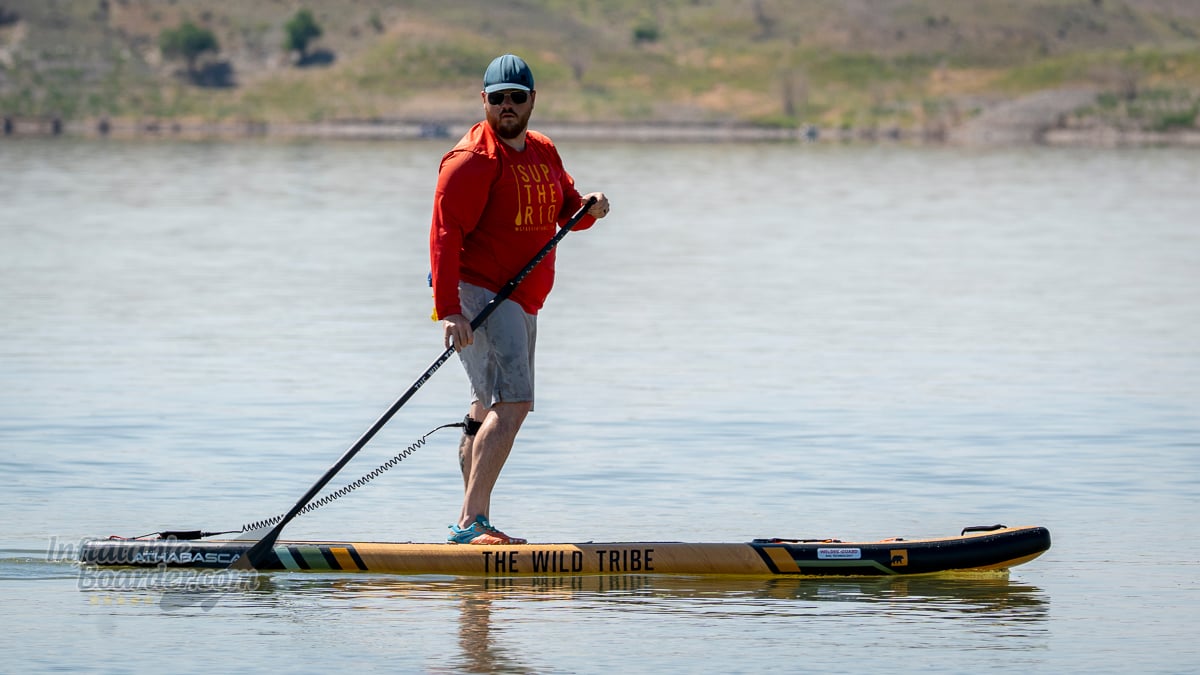
I did not notice any flex in the board when standing and paddling normally
With the Athabasca 11’ inflated to its maximum pressure we put it through our standardized bend test. With 170 pounds of weight in the standing area of the board, it bent 2.2”. I was a little surprised at this result as it is notably more flex than the Naia 11′ we tested last year. They do have a different internal construction, and the Naia was significantly heavier. It is possible that in order to reduce weight they also moved to a slightly lighter PVC material for the Athabasca, which would have the effect of reducing rigidity.
But, what really matters is how the Athabasca feels on the water. And it’s not what the bend test would have you expect.
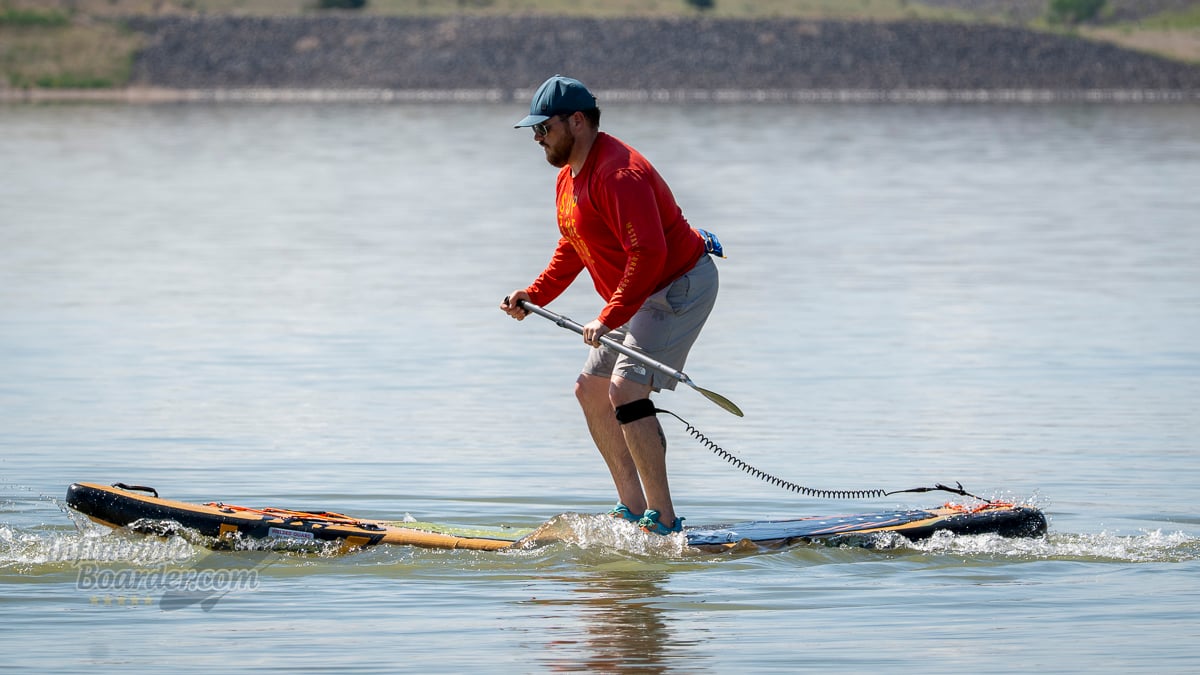
There is noticeable flex when paddling hard or bouncing on the board.
On the water the Athabasca feels much better than its bend test score implies. I didn’t notice any bend or flex in the board when standing and paddling normally at a cruising pace.
I could, however, feel the board begin to flex as I picked up my tempo to paddle faster, and really felt it flex during our sprint testing. When bouncing on the board it has a high flex profile, but a typical rebound feeling – not too soft or springy.
While the overall board rigidity is lower than on the Naia 11’, it still feels good while paddling and the new welded seams and lighter construction are a welcome addition for the Athabasca.
The Wild Tribe Athabasca 11’ iSUP — Specifications
Specifications
| Dimensions | |
| Length | 11’ 0” |
| Width | 32.5“ |
| Thickness | 4.7“ |
| Weight | |
| Max Capacity | 330 pounds |
| Board Weight | 21.8 pounds |
| Kit Weight (SUP & accessories) | 33 pounds |
| Buying Info | |
| List Price | $849 |
| Warranty | 3 years |
| Returns period | 30 days |
The Wild Tribe Athabasca 11’ iSUP Review — Features, Accessories and Versatility
As an all-around paddle board, the Athabasca 11’ is outfitted with a variety of features to accommodate just about anything you’d like to do, and has a shape that is likewise versatile on the water.
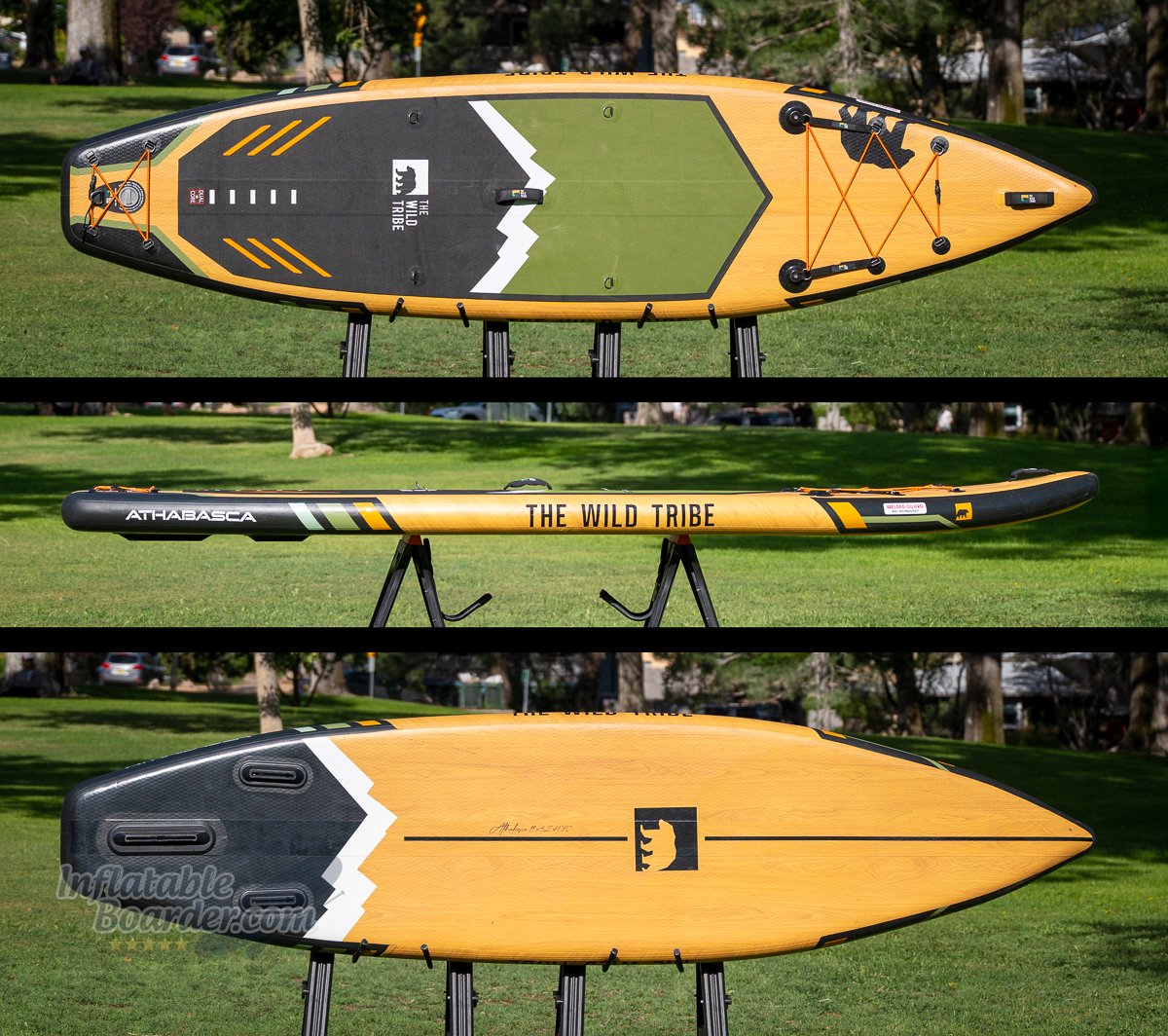
The Wild Tribe Athabasca 11’ is 11’ 0” long, 32” wide, 4.7” thick, and weighs 21.4 pounds. It has a maximum internal pressure rating of 20 PSI and a recommended capacity of 330 pounds.

The Athabasca has a hybrid/crossover shape with a tapered nose for greater paddling efficiency.
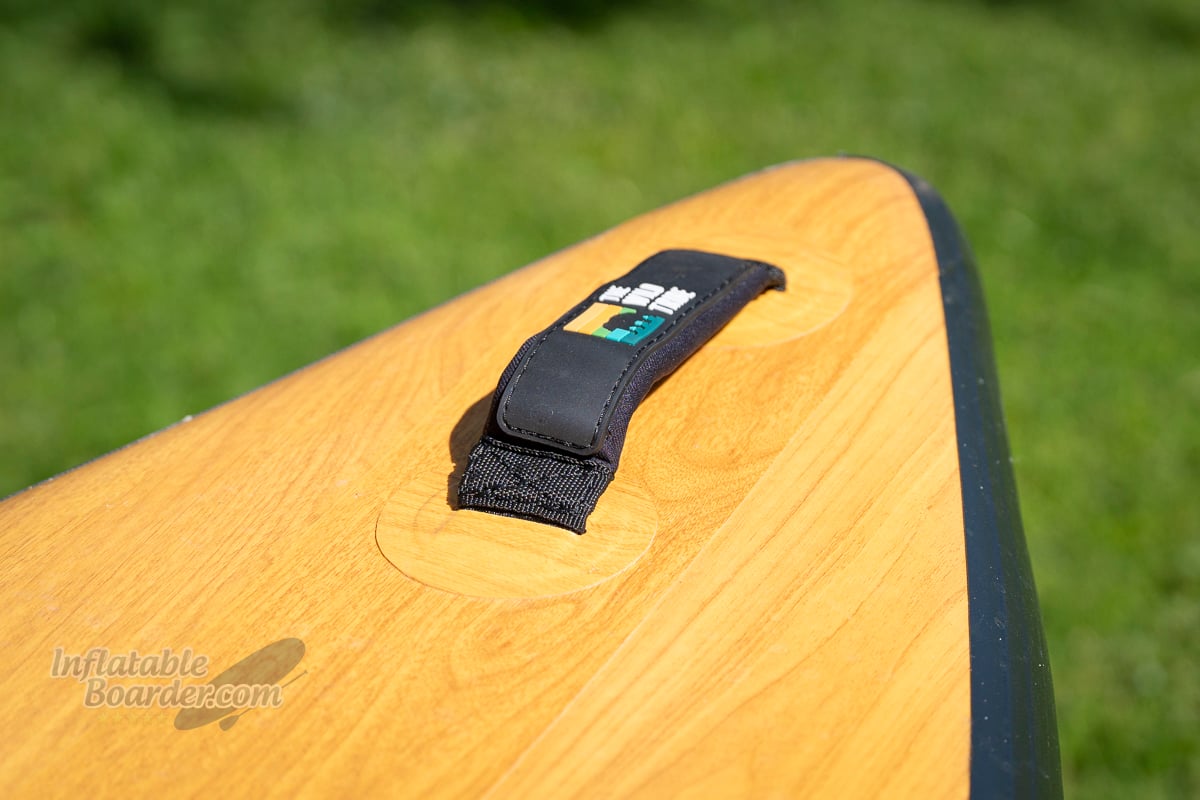
There are only two carrying handles on the Athabasca 11’ – in the center of the board and at the Nose. By not having a tail handle, the Athabasca is harder to carry with a partner, but at just over 21 pounds it’s a lightweight board that should be easy for most paddlers to handle off the water.

The front cargo area has a fixed bungee cord strung between 6 D-rings. It’s a medium size cargo space that can hold soft-sided coolers and 20L dry bags without much stress. There are also two removable passenger handles.
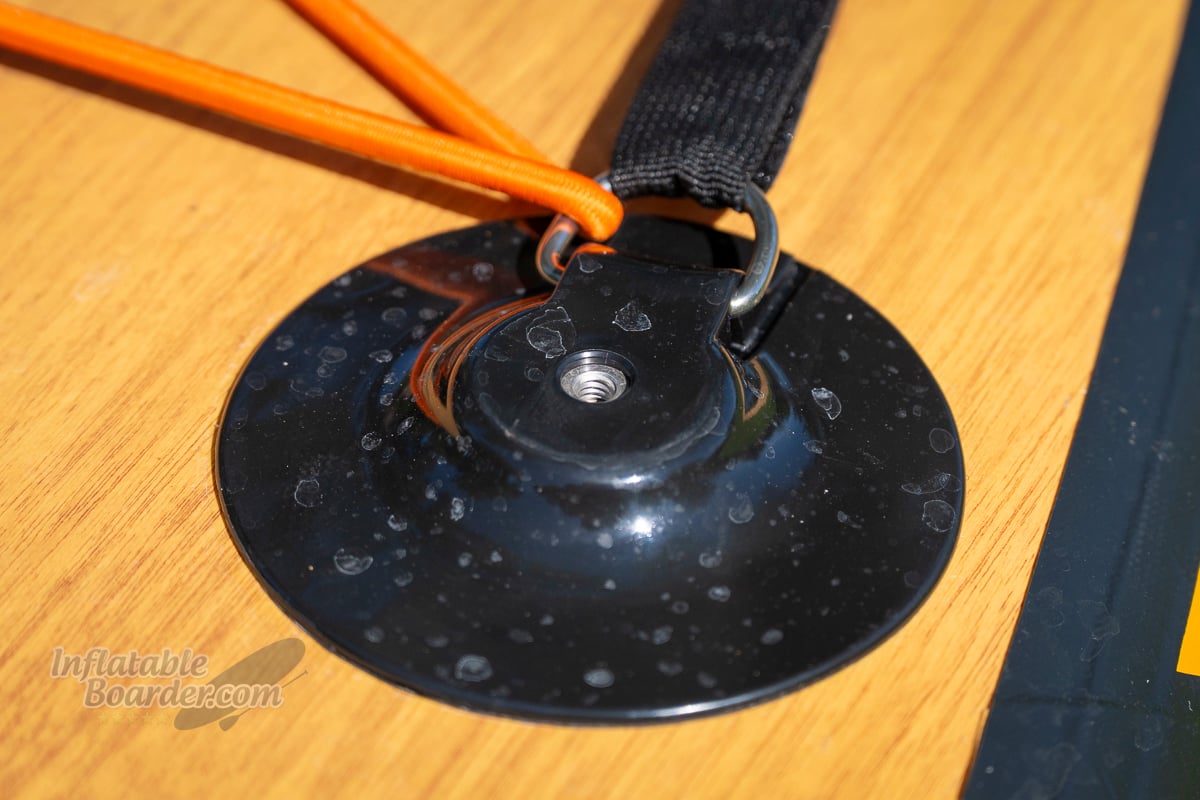
The two D-rings closest to the standing area are integrated into threaded accessory mounting points for items like fishing rod holders, cameras, and more.

There are four more D-rings on the deck of the board for kayak seat compatibility.
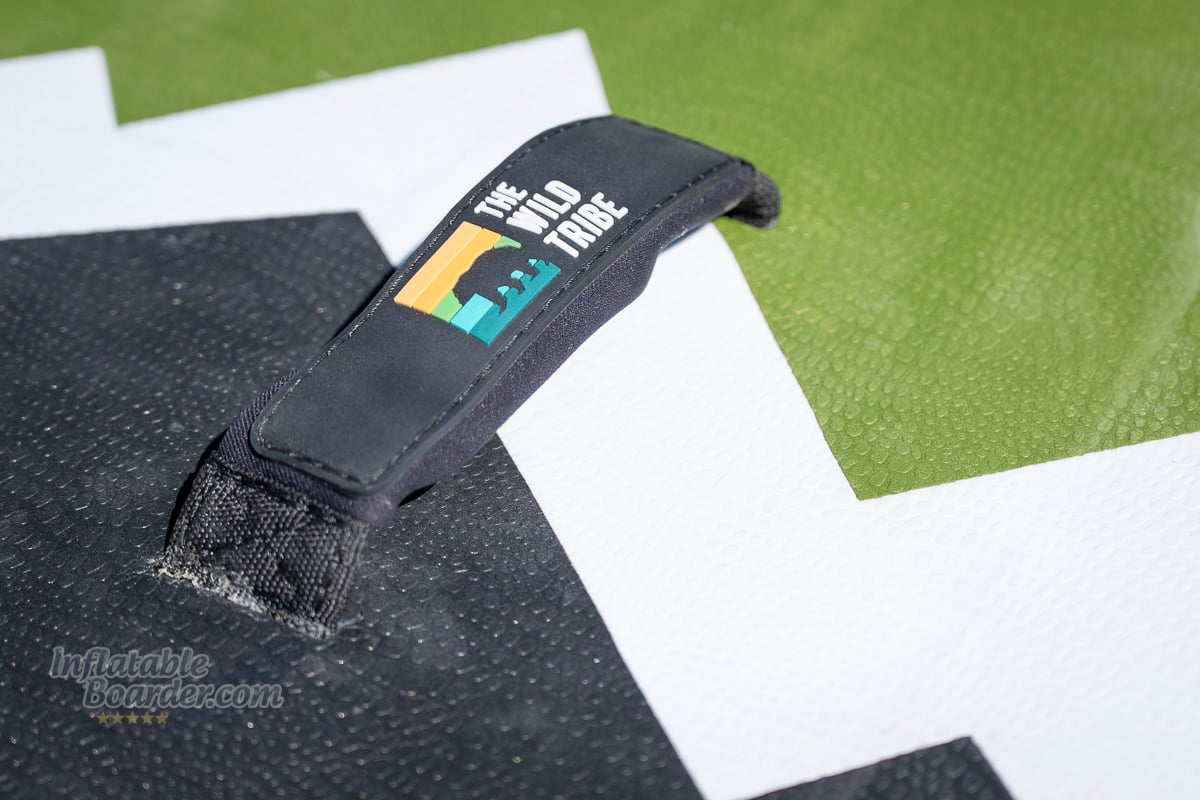
The deck pad is made with a die-cut EVA foam with a pebbled texture. This gives the board a comfortable feel on your skin while still providing plenty of traction.
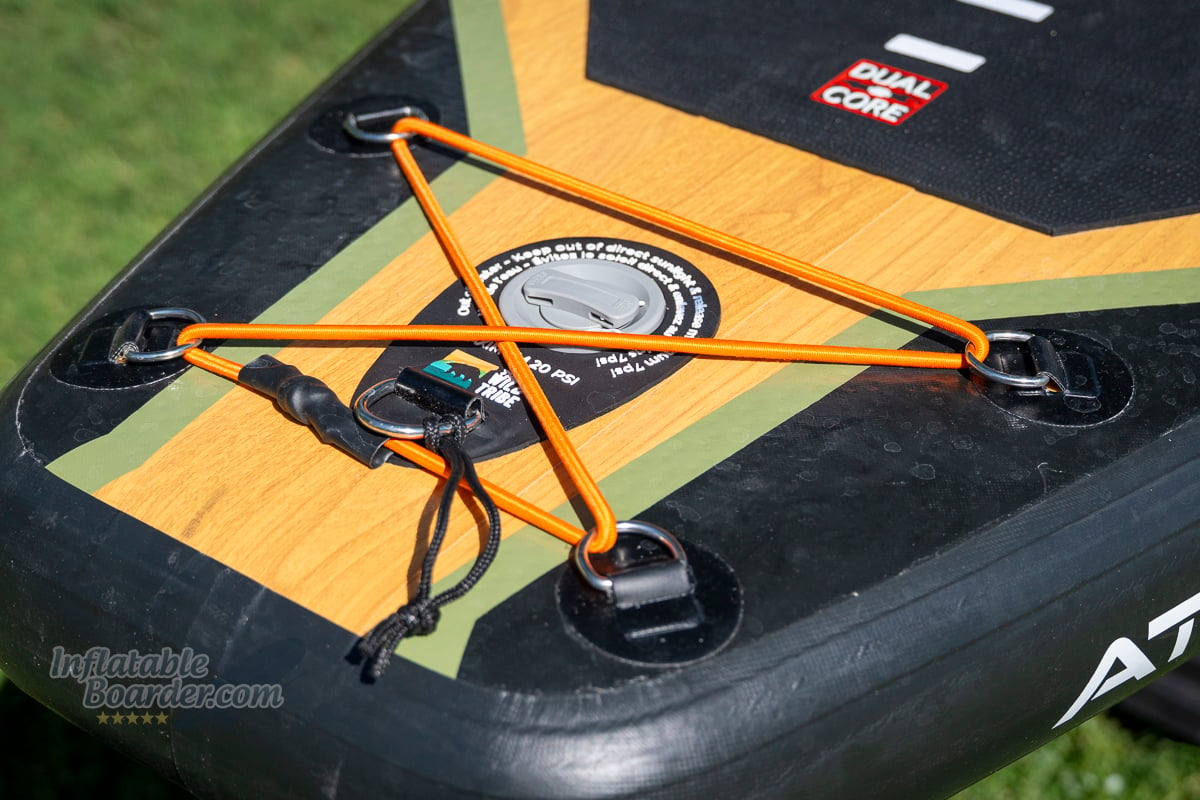
The rear cargo area is quite small. You can use it to hold things like sandals or a water bottle, but not much more. It also encompasses the inflation valve and leash D-ring.

The tail has a wider square shape for improved stability and capacity.

Under the tail there is a US fin box for the center fin and two proprietary fin boxes for the side fins. These side fin boxes are also toed-in to the center of the board. This type of side fin box setup is really only useful on higher-performance surf boards that rely on asymmetrical pressure on a wave face. On an all-around / touring crossover like the Athabasca they add just a little bit of tracking performance, but mostly drag under the board.

The Athabasca 11’ comes with a full kit of accessories.
The Athabasca 11’ comes with a full kit of accessories including:
- Athabasca 11’ iSUP
- 3-piece carbon fiber/nylon paddle
- Double-action hand pump
- Wheeled carrying bag
- 1-9” and 2-4.5” fins and fin bag
- Coiled leash
- Repair kit
With the multiple threaded accessory mounts and over a dozen D-rings, you can rig the Athabasca 11’ for just about adventure on the water.
The Wild Tribe Athabasca 11’ iSUP Review — Paddle
The Wild Tribe is packaging a new carbon fiber / nylon hybrid paddle with the Athabasca 11’ that is lighter and more comfortable to use than their previous aluminum paddle.
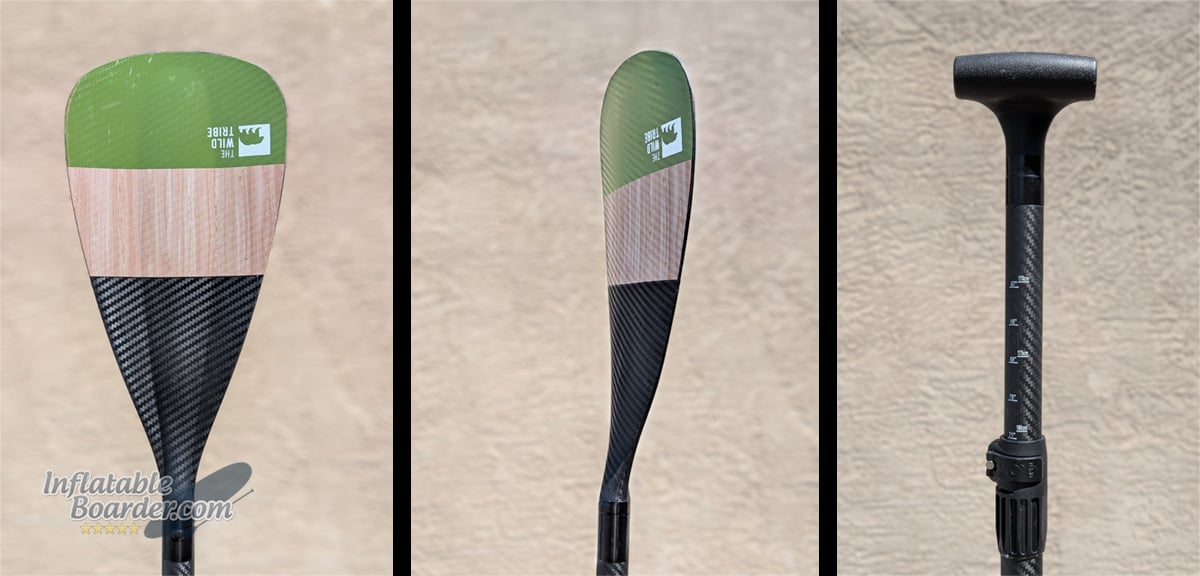
The Wild Tribe carbon hybrid paddle has a medium size teardrop blade and ergonomic T-grip.
The new carbon fiber hybrid paddle from the wild tribe blends a carbon fiber shaft and handle section and fiber-reinforced nylon blade to create a midweight paddle that flexes comfortably in the water for all-day paddling.
The new paddle is significantly lighter than the previous aluminum version – just over 27 ounces – and the composite construction allows the paddle shaft to flex comfortably during the paddle stroke but won’t deform the paddle. When paddling fast there is a little too much flex – though mostly in the blade, but for all-day cruising and day touring it’s just enough to help reduce fatigue.
The blade has a medium-large teardrop shape that provides a comfortable amount of power. There’s a minor scoop from throat to toe on the power face and also a bend from edge to edge. This can be a little confusing for new paddlers to know which way to orient the blade, especially with the same graphic design on each side.
The handle section has length markings to easily reset the paddle between uses, but does not have any indexing marks or grooves, so you’ll need to align the T-grip and the blade together after each adjustment.
The Wild Tribe Athabasca 11’ iSUP Review — Stability
The Athabasca 11’ has a few design elements that help give it more stability than what you would expect by just looking at its size or listed capacity.

The wide tail and lower deck height improve the Athabasca’s stability.
One of the biggest advantages of using a thinner, 4.7”, drop stitch core is lowering the paddler’s center of gravity. It may not seem like much, but it’s over 20% lower to the water than a standard 6” board. That gives the Athabasca an improved feeling of stability on the water and also helps the board feel more connected to the water rather than floating higher on the surface.
In addition to the thinner profile, the wide, square tail helps keep the board wider throughout its length and makes it harder for the board to roll side to side.

The 4.7” thickness leads to more stability in all conditions, and the wider tail shape prevents the edges from grabbing under water when the board is tilted.
The result is an extremely stable feel for a 32” wide board. On the water I could not feel any rolling or twitching, and it handled boat wake with ease. The wider outline in the rear of the board makes it easy to hold on its edge, and the rails smoothly submerged and resurfaced when rocking the board side to side.
Paddlers over 220 pounds / 100kg will notice a bit more flex in the board compared to lighter paddlers. As mentioned above it still felt very good for me (230 lbs) during casual use, but had noticeable flex when paddling a little hard and when moving around on the board. But overall I was very impressed with the Athabasca’s stability at just 32” wide.
The Wild Tribe Athabasca 11’ iSUP Review — Speed
The Athabasca 11’ has a typical speed profile for an all-around iSUP, but does paddle efficiently at cruising speeds.

The Athabasca 11’ can move when you want it to, but is limited by board and paddle flex.
We test a few different aspects of paddleboard speed for each review. We like to look at top speed as a benchmark measure for comparison, but it’s not always that useful of a spec for most paddlers, especially with an all-around board.
In our sprinting and top-speed tests, the Athabasca 11’ paddled at 4.7 and 5.1 MPH respectively. That is pretty typical for an 11’ x 32” all-around paddle board. When paddling harder I could feel the board and paddle both flexing which does reduce overall speed. But the new carbon fiber hybrid paddle feels good in the hand and is comfortable to paddle with.
At a more typical cruising pace (around 25 strokes per minute) the Athabasca 11’ again has a typical speed of about 3.7 MPH on average. That’s a nice clip for an all-around board. What was more impressive though was the efficiency and gliding performance. From this cruising speed a single paddle stroke drove the Athabasca forward around 21 feet, or 1.9 board lengths, before I could feel the board begin to slow down. That’s very efficient for an all-around iSUP and is well within the range we typically see in boards with more dedicated shapes for touring.
The Wild Tribe Athabasca 11’ iSUP Review — Maneuverability and Tracking
With a crossover shape between an all-around and touring board, it came to no surprise to me that the Athabasca tracks very well, but can still be maneuvered with ease.

Flat-turning the Athabasca 11’ is relatively easy, but can be made easier by only using the center fin.
The Athabasca 11’ did well in our maneuverability test, coming in right at average across our scoring. It takes an average of 7 full forward sweep strokes to turn the Athabasca in a full circle from a standstill, with the first two strokes easily turning the board 90°. Using a reverse sweep stroke turns the board much quicker as it works against the fins, but will slow any forward momentum you may have if turning while paddling. While paddling at a cruising pace I also found steering the board to be easy with basic sweep strokes.
The extra stability and wider tail shape makes it easy to walk to the back of the board to lift the nose for a pivot turn. I could feel the board flex a little as I walked, but not so much that it made the maneuver more difficult. If you are used to doing this with a 6” thick board, though, you may want to take it easy for your first few turns as the thinner profile is faster to dip beneath the surface.

The Athabasca 11’ tracks quite straight for an 11’ board.
The agility performance of the Athabasca is typical for an all-around paddle board, but the tracking performance is definitely better than average. After 10 paddle strokes on a single side, the Athabasca 11’ only deviated an average of 12° off course. With more casual paddling and more frequent switching, it’s very easy to paddle where you are pointed.
At faster speeds the board flex does make it a little bit harder to maintain course, but this really only happens when you paddle beyond a comfortable sustained cruising speed.

The side fins are toed-in and use a proprietary fin box.
There are three fin boxes under the tail of the Athabasca 11’ and we always do our testing with the full setup provided, as that is how most paddlers will use their boards. Most all-around paddle boards do not need a 2+1 fin setup like this, especially with toed-in side fins (pointed toward the middle of the board). This design is used more commonly in intermediate-level surf SUPs and surfboards as the side fins provide lift while surfing at an angle to the wave face. A single 9” fin is usually sufficient for paddlers who aren’t surfing.
The side fins do provide some tracking support, but also make the board harder to turn. If you are wanting a more maneuverable experience on the water, simply remove the side fins for quicker turns with a small change in tracking.
The Wild Tribe Athabasca 11’ iSUP Review — Warranty and Customer Support
The Wild Tribe offers a 3-year warranty for their inflatable paddle boards and a 6-month warranty for all of their accessories. This is a mid-length board warranty, but a slightly short accessory warranty. They also have a longer, 45-day return period for their products. If you have any questions about The Wild Tribe’s products or need to file a warranty claim, you can contact them via email, phone, webform, social media, or at their headquarters outside of Montreal, Quebec.
The Wild Tribe Athabasca 11’ iSUP Review — Final Thoughts

The Athabasca 11’ is a versatile and well-built board for paddlers of all skill levels.
The Athabasca’s crossover design does a fantastic job of creating versatility and usability on the water for paddlers of all skill levels. It has great stability for new paddlers, but paddles efficiently for fitness sessions or day touring. It’s loaded up with multiple cargo and accessory mounting points to let you bring whatever items you need for the day. The Wild Tribe’s new construction is lightweight and durable. If you are looking for a high-value board that can grow with you and offer a number of uses on the water, the Athabasca 11’ is a great option.




Leave a Reply